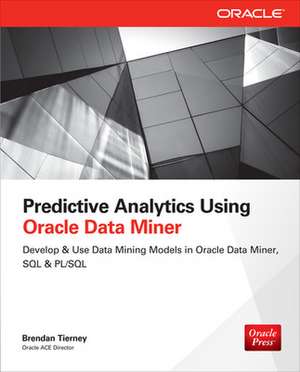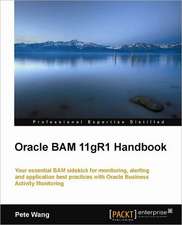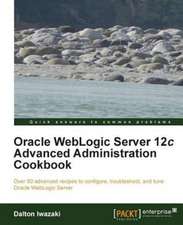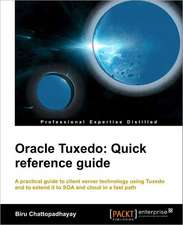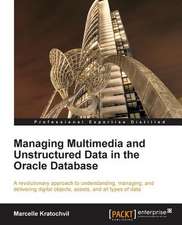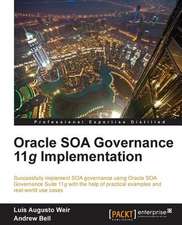Predictive Analytics Using Oracle Data Miner
Autor Brendan Tierneyen Limba Engleză Paperback – 16 iun 2014
Build Next-Generation In-Database Predictive Analytics Applications with Oracle Data Miner
“If you have an Oracle Database and want to leverage that data to discover new insights, make predictions, and generate actionable insights, this book is a must read for you! In Predictive Analytics Using Oracle Data Miner: Develop & Use Oracle Data Mining Models in Oracle Data Miner, SQL & PL/SQL, Brendan Tierney, Oracle ACE Director and data mining expert, guides you through the basic concepts of data mining and offers step-by-step instructions for solving data-driven problems using SQL Developer’s Oracle Data Mining extension. Brendan takes it full circle by showing you how to deploy advanced analytical methodologies and predictive models immediately into enterprise-wide production environments using the in-database SQL and PL/SQL functionality. Definitely a must read for any Oracle data professional!” --Charlie Berger, Senior Director Product Management, Oracle Data Mining and Advanced AnalyticsPerform in-database data mining to unlock hidden insights in data. Written by an Oracle ACE Director, Predictive Analytics Using Oracle Data Miner shows you how to use this powerful tool to create and deploy advanced data mining models. Covering topics for the data scientist, Oracle developer, and Oracle database administrator, this Oracle Press guide shows you how to get started with Oracle Data Miner and build Oracle Data Miner models using SQL and PL/SQL packages. You'll get best practices for integrating your Oracle Data Miner models into applications to automate the discovery and distribution of business intelligence predictions throughout the enterprise.
- Install and configure Oracle Data Miner for Oracle Database 11g Release 11.2 and Oracle Database 12c
- Create Oracle Data Miner projects and workflows
- Prepare data for data mining
- Develop data mining models using association rule analysis, classification, clustering, regression, and anomaly detection
- Use data dictionary views and prepare your data using in-database transformations
- Build and use data mining models using SQL and PL/SQL packages
- Migrate your Oracle Data Miner models, integrate them into dashboards and applications, and run them in parallel
- Build transient data mining models with the Predictive Queries feature in Oracle Database 12c
Preț: 477.78 lei
Preț vechi: 665.91 lei
-28% Nou
Puncte Express: 717
Preț estimativ în valută:
91.44€ • 95.11$ • 75.48£
91.44€ • 95.11$ • 75.48£
Carte tipărită la comandă
Livrare economică 17-22 aprilie
Preluare comenzi: 021 569.72.76
Specificații
ISBN-13: 9780071821674
ISBN-10: 0071821678
Pagini: 464
Ilustrații: illustrations
Dimensiuni: 188 x 231 x 23 mm
Greutate: 0.79 kg
Editura: McGraw Hill Education
Colecția McGraw-Hill
Locul publicării:United States
ISBN-10: 0071821678
Pagini: 464
Ilustrații: illustrations
Dimensiuni: 188 x 231 x 23 mm
Greutate: 0.79 kg
Editura: McGraw Hill Education
Colecția McGraw-Hill
Locul publicării:United States
Cuprins
Part One: Orale Data Miner Fundamentals
1: Oracle Data Miner
2: The Predictive Model Lifecycle
3: How to Install, Set-up and Get Started
Part Two:Usng the Oracle Data Miner Tool
4: ODM Menus, Projects and Workflows
5: Exploring your data
6: Data Preparation
7: Association Rule Analysis
8: Classification
9: Clustering
10: Regression
11: Anomaly Detection
Part Three: Data Mining Using SQL and PL/SQL
12: The ODM Data Dictionary, SQL and PL/SQL
13: Data Preparation
14: Association Rule Analysis
15: Classification
16: Clustering
17: Regression
18: Anomaly Detection
Part Four: Migration and Implementations
19: How to Migrate you ODM Models
20: Implementation Related Topics
1: Oracle Data Miner
2: The Predictive Model Lifecycle
3: How to Install, Set-up and Get Started
Part Two:Usng the Oracle Data Miner Tool
4: ODM Menus, Projects and Workflows
5: Exploring your data
6: Data Preparation
7: Association Rule Analysis
8: Classification
9: Clustering
10: Regression
11: Anomaly Detection
Part Three: Data Mining Using SQL and PL/SQL
12: The ODM Data Dictionary, SQL and PL/SQL
13: Data Preparation
14: Association Rule Analysis
15: Classification
16: Clustering
17: Regression
18: Anomaly Detection
Part Four: Migration and Implementations
19: How to Migrate you ODM Models
20: Implementation Related Topics
